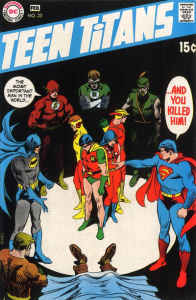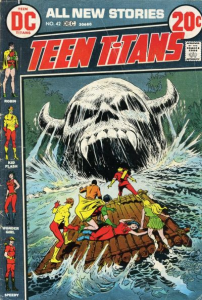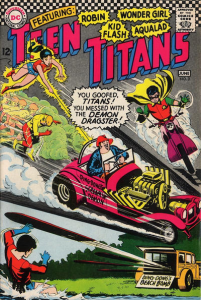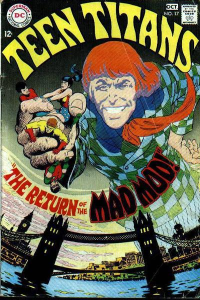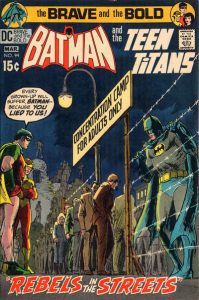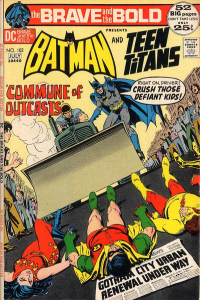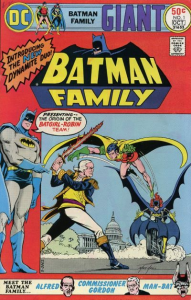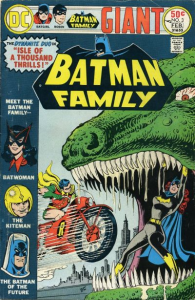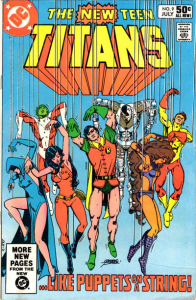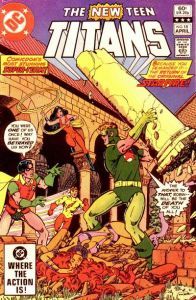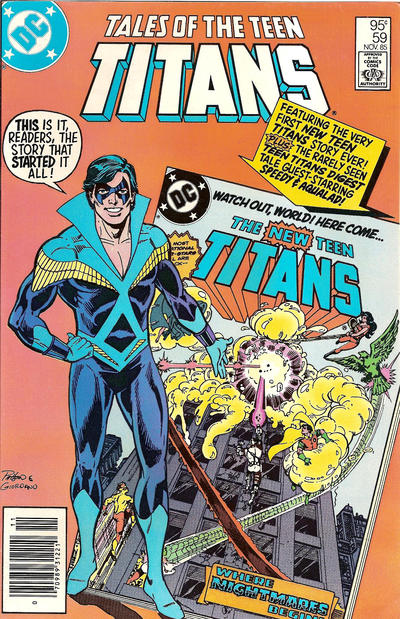If Dick Grayson’s childhood was pretty unusual, his adolescence was totally out there.
While Detective Comics didn’t promote him from Boy Wonder to Teen Wonder until 1970, in the mid-60s Robin became a founding member of the Teen Titans:
The Teen Titans comic revolved around a team made up of young sidekicks, including Robin, Kid Flash, Wonder Girl, Aqualad, and, later, Speedy (the sidekicks of Batman, Flash, Wonder Woman, Aquaman, and Green Arrow, respectively). Because the series sought to appeal to teen readers, the villains were often lifted from current trends. And because the writer was Bob Haney, the result was close to insane:
Like other comics of the era, the series was shamelessly political. In the very first issue, the Teen Titans joined the Peace Corps and went on a mission to South America (which involved fighting a giant conquistador robot, because Bob Haney). In the third issue, Washington enrolled the Titans in a national campaign to persuade dropouts to stay in school. There were also stories in which the team joined Uncle Sam’s ‘good neighbor’ cultural exchange campaign with other nations (but not before saluting a picture of JFK) and helped rescue the foreign student exchange program from American xenophobes (and from a German spy). In ‘Eye of the Beholder,’ the Titans befriended a Soviet superhero. In ‘The Titans Kill a Saint?’ they agonized over the death of a Nobel Peace Prize laureate at an anti-war protest.
And then there is the issue where the Titans travel to Hippieville, which is as trippy as it sounds…

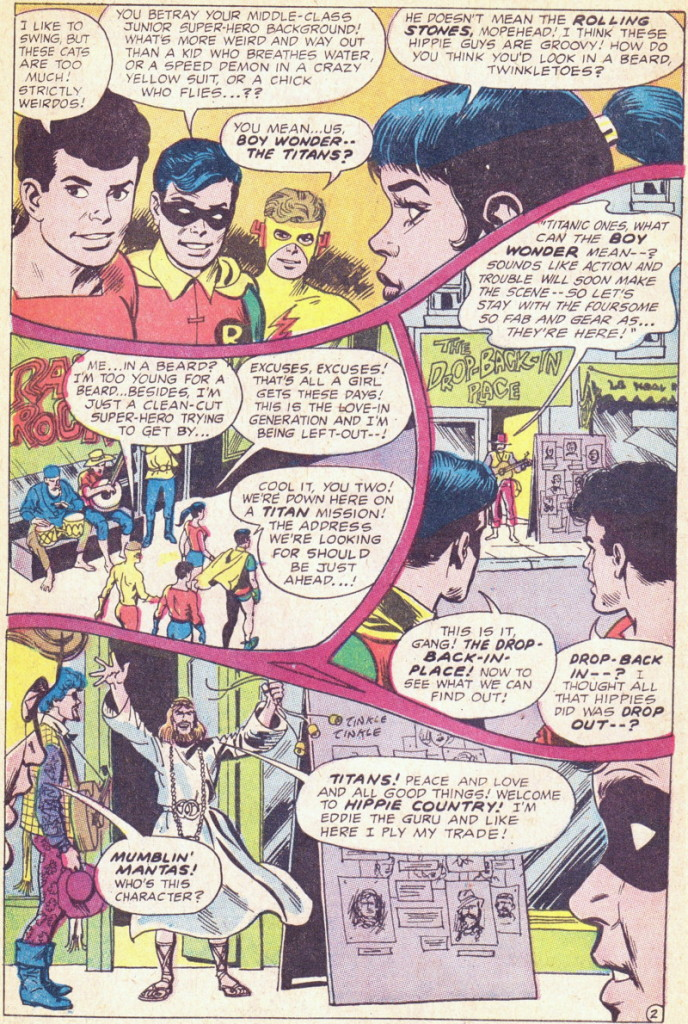 Teen Titans #15
Teen Titans #15
Robin’s adventures with the Teen Titans didn’t prevent him from continuing to fight crime alongside Batman. But in 1969 the Dynamic Duo did finally break up as Dick Grayson moved out of Wayne Manor and left for Hudson University. The editorial reasoning behind this was probably to let the Dark Knight do his Sturm und Drang brooding alone, which would suggest Dick was no longer necessary as a character in Batman’s world. However, as demonstrated by the Teen Titans comic, with the rise of youth culture Robin may have been more relevant than ever.
Some Batman stories had already begun to explicitly address the generation gap, not so much within the Dynamic Duo, but in the cast of suspects of crimes they investigated (most notably in Detective Comics#387 and #393). The last story before Robin leaves is a great example. On the one hand, Dick is kind of a useless sidekick – his major contribution, I kid you not, is to distract a bunch of goons by surfing under the moonlight. On the other hand, Dick serves as a link to a new generation, giving us access to some groovy dialogue:
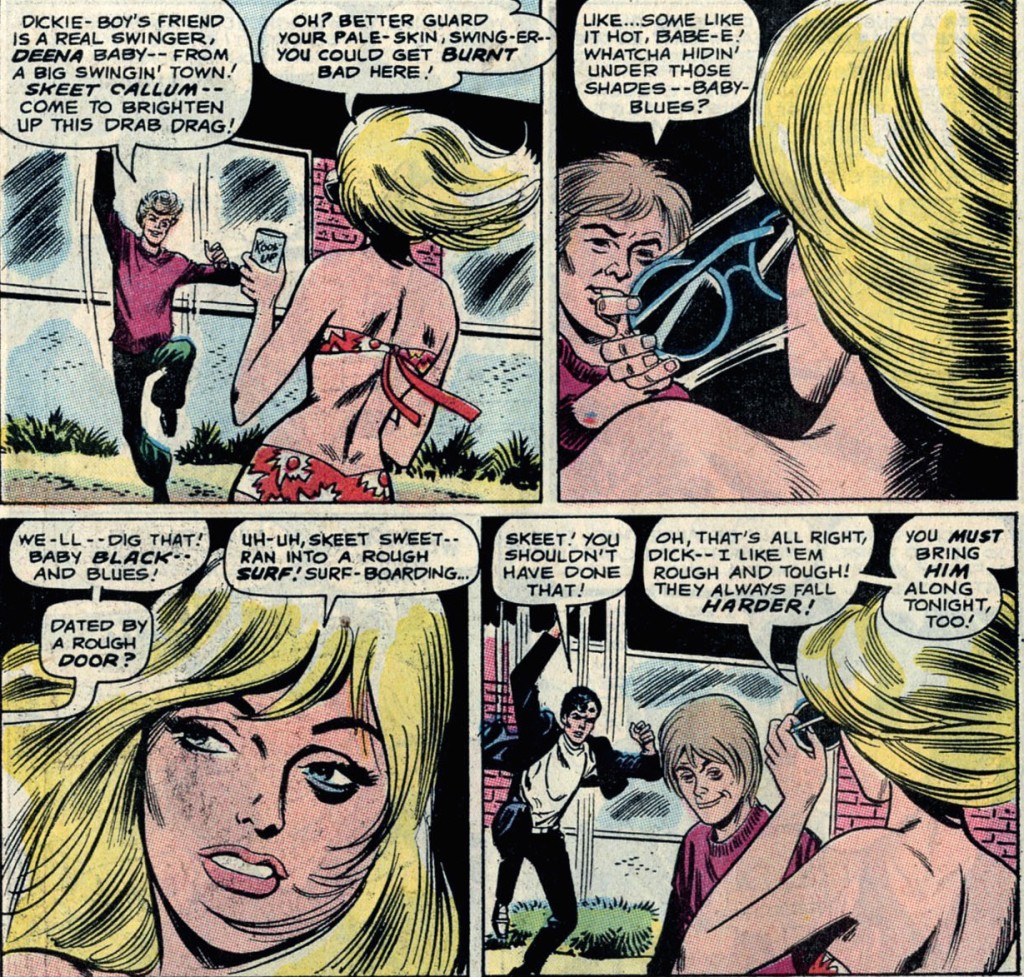 Detective Comics #393
Detective Comics #393
Robin transitioned to solo adventures in the backup features of Batman and Detective Comics, which depicted Hudson University as a hub of student counterculture. In ‘Vengeance for a Cop,’ an officer describes the campus’ outskirts as ‘the border between the U.S.A. and the Woodstock Nation.’ These comics treaded the line between staying attuned to the latest trends and remaining faithful to Robin’s pro-establishment respect for law and order, with scripting duties alternating between the hippie Denny O’Neil and the cynical Frank Robbins, as well as twenty-year-olds Mike Friedrich and Elliot S! Maggin.
Needless to say, though, as usual the most outlandish take on the subject came from Bob Haney in The Brave and the Bold, where Gotham City was temporarily taken over by a youth rebellion movement called STOPP – Society To Outlaw Parent Power.
The bulk of Robin’s tales were written by Mike Friedrich, himself in college at the time. These stories aren’t much fun (or any good, really) but they do provide a fascinating glimpse into the early 1970s. Friedrich’s Robin kept a balanced position on the culture wars, as he sought to restrain both sides of the national divide. For a character rooted in righteous vengeance and violent crime-fighting, Dick Grayson increasingly came across as a pacifist, constantly appealing to calm and dialogue, whether talking to the police, to his colleagues, or to the Jesus people.
Thus, instead of kicking butt, Dick now spent most of the time trying to prevent conflict:
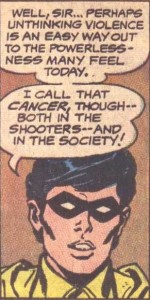 Batman #234
Batman #234
He even recruited Superman’s help to make the point:
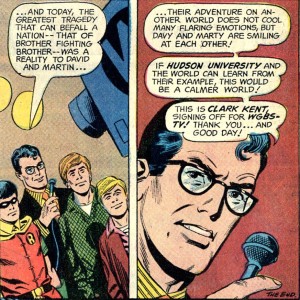 World’s Finest Comics #200
World’s Finest Comics #200
Robin’s ‘pacifism’ would also help distinguish him from his mentor:
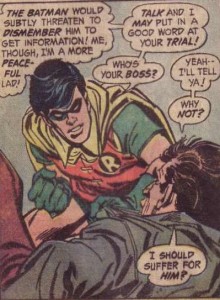 Batman #257
Batman #257
Meanwhile, back home the Caped Crusader himself was getting a makeover. Bruce Wayne became more of an activist entrepreneur, replaced the Batmobile with a fashionable sports car, and even left the old mansion for a modern penthouse in central Gotham. Or to put it in Batman terms:
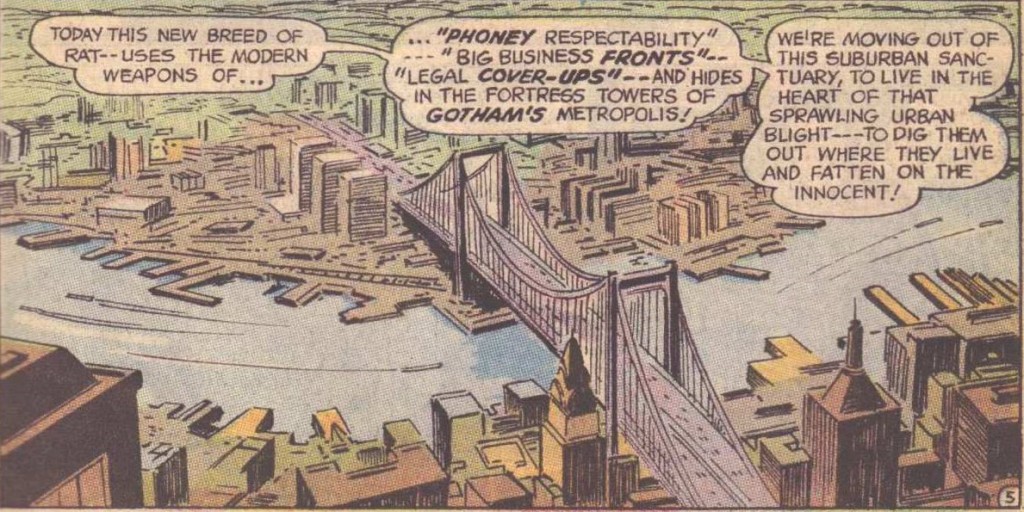 Batman #217
Batman #217
With Batman now mostly working alone and Robin’s presence in the main titles reduced to rare appearances, the notion of a Dynamic Duo seemed more and more pointless. Even when Dick Grayson occasionally popped up for a supporting bit, his role was usually that of a weak link in need of rescue, such as in ‘Daughter of the Demon’ or in ‘How Many Ways Can a Robin Die?’
Things changed a bit in the mid-70s, with Robin guest-starring more often and being given a more active role in the stories, not to mention a cockier attitude. Having successfully reestablished Batman’s stripped down hardass street cred, writer Denny O’Neil was now lightening things up by revitalizing old concepts and characters who had hardly been seen since the ’60s. O’Neil even embraced Robin’s punning tendencies, although not without some ironic self-awareness – wordplay was presented as not just a throwback to another era, but as a symbol of childishness:
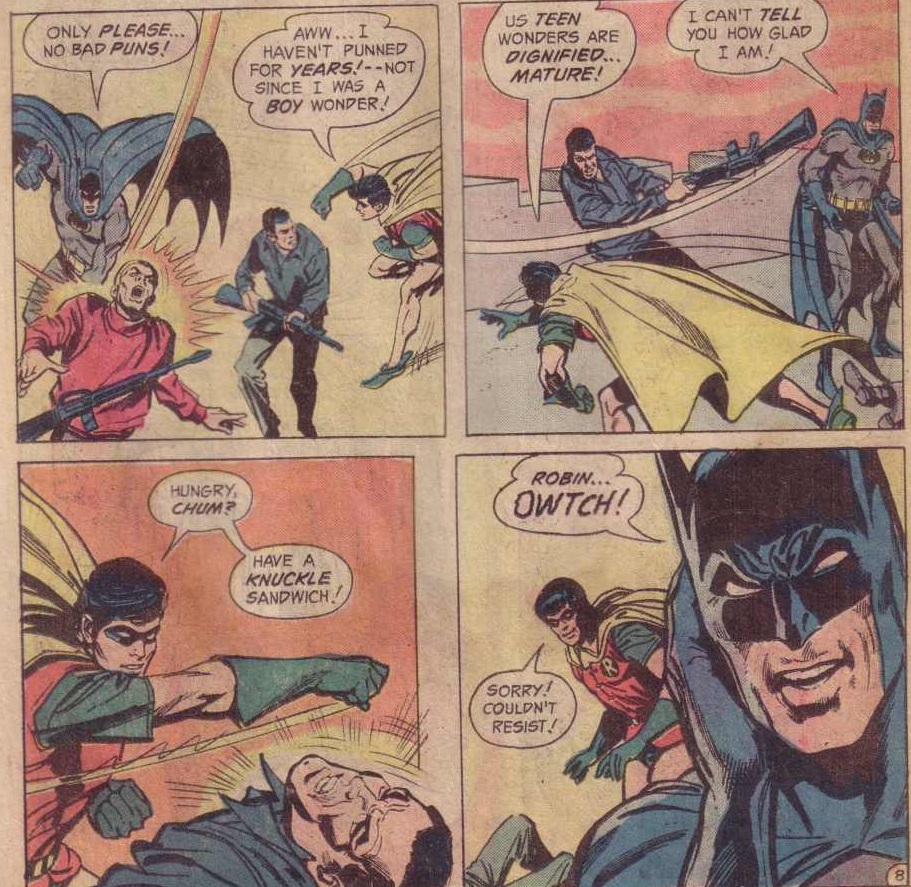 Batman #257
Batman #257
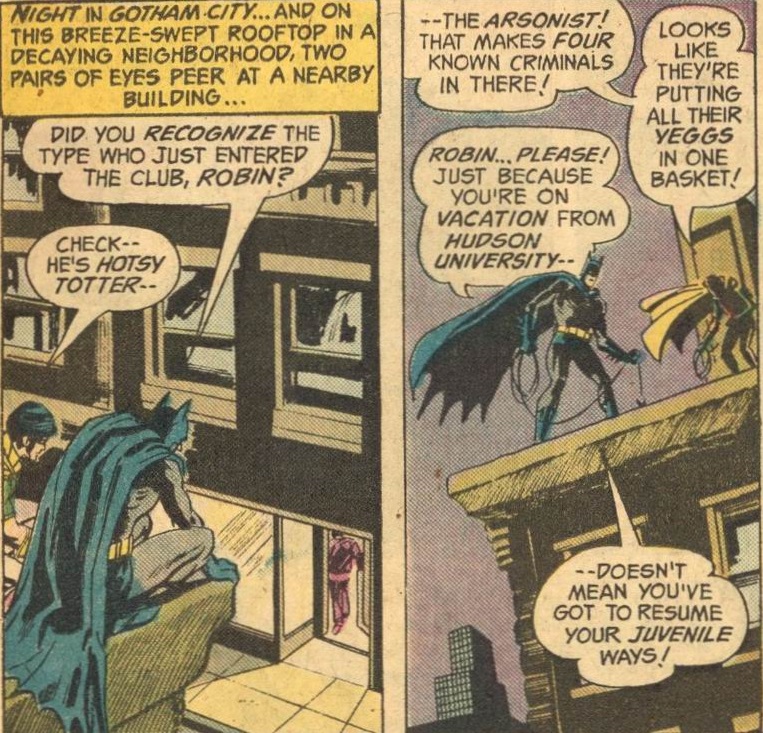 Batman #258
Batman #258
With his teen hormones bouncing around, Dick Grayson also became much more of a ladies’ man. For one thing, he openly flirted with Batgirl in between fighting demons and dinosaurs on the pages of Batman Family:
But it wasn’t just Batgirl….
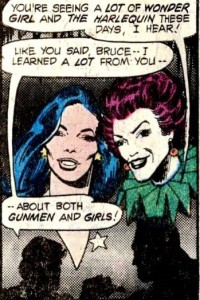 Detective Comics #474
Detective Comics #474
By the time they were reaching their twenties, the Teen Titans had clearly outgrown their teen sidekick identities and so they disbanded the team. Maybe they realized they looked kind of silly in those costumes now that they had to shave every day, or maybe they just couldn’t put up with Kid Flash anymore… In any case, they soon overcame these issues, because in 1980 Marv Wolfman and George Pérez revived the team for what would become one of the most popular comic series of the decade:
In the early ’80s, Dick Grayson’s relationship with Batman became more and more estranged. In typical coming-of-age fashion, Dick dropped out of college and fell in love with an alien princess. Finally, in 1984, he put his Robin suit away for good and adopted a less tacky look.
Well, arguably:

